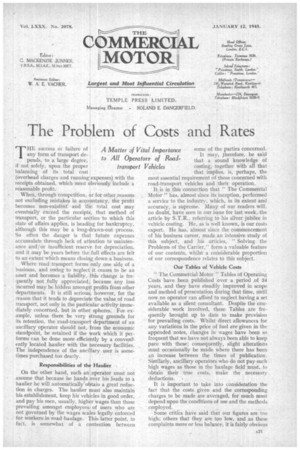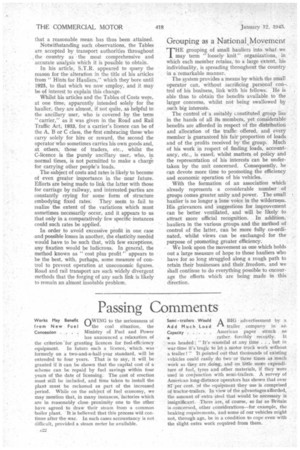The Problem of Costs and Rates
Page 23

Page 24

If you've noticed an error in this article please click here to report it so we can fix it.
THE success or failure ot any form of transport depends, to a large degree, if not solely, upon the proper balancing of its total cost (overhead charges and running expenses) with the receipts obtained, which must obviously include a reasonable profit.
When, through competition, or for other reasons not excluding mistakes in accountancy, the profit becomes non-existent and the total cost may eventually exceed the receipts, that method of transport, or the particular section to which this state of affairs applies, is heading for bankruptcy, although this may be a long-drawn-out process. So often the danger is that future expenses accumulate through lack of attention to maintenance and/or insufficient reserve for depreciation, and it may be years before the full effects are felt to an extent-which means dosing down a business.
Where road transport forms only one side of a business, and owing to neglect it ceases to be an asset and becomes a liability, this change is frequently not fully appreciated, because any loss incurred may be hidden amongst profits from other departments. It is still seriouS, however, for the reason that it tends to depreciate the value of road transport, not only in the particular activity immediately concerned, but in other spheres. For example, unless there be very strong grounds for its retention, the road-transport department of an ancillary operator should not, from the economic standpoint, be retained if the work which it performs can be done more efficiently by a conven?ently located haulier with the necessary facilities. The independence of the ancillary user is sometimes purchased too dearly.
Responsibilities of the Haulier On the other hand, such an operator must not assume that because he hands over his Joads to a haulier he will automatically'abtain a great reduction in charges. The haulier must also maintain his establishment, keep his vehicles in good order, and pay his men, usually, higher wages than those prevailing amongst employees of users who are not governed by the wages scales legally enforced for workers in road haulage. This latter point, in fact, is somewhat of a contention between some of the parties concerned.
It may, therefore, be said that a sound knowledge of costing,together with all that that implies, is, perhaps, the most essential requirement of those concerned with road-transport vehicles and -their operation.
It.iS in this connection that " The Commercial Motor" has, almost since its inception, performed a service to the industry, which, in its extent and accuracy, is supreme. Many of our readers will, no doubt, have seen in our issue for last week, the article by S.T.R., referring to his silver jubilee in vehicle costing. He, as is well known, is our costs expert. He has, almost since the commencement of his business career, made an intensive study of this subject, and his articles, " Solving the Problems of the Carrier," form a valuable feature of our contents, whilst a considerable proportion of our correspondence relates to this subject.
Our Tables of Vehicle Costs "The Commercial Motor " Tables of Operating Costs have been published over a period of 34 years, and they have steadily improved in scope and method of presentation during that time, until now no operator can afford to neglect having a set available as a silent consultant. Despite the considerable work involved, these Tables are frequently brought up to date to make provision for prevailing costs. Whilst direct allowances for any variations in the price of fuel are given in the appended notes, Changes in wages• have been so frequent that we have not always been able to keep pace with these; consequently, slight alterations must occasionally be made where there has been an increase between the times of publication. Similarly, ancillary operators who do not pay such high wages as those in the haulage field must, to obtain their true costs, make the necessary deductions. • It is important to take into consideration the fact that the costs given and the corresponding charges to be made are averaged, for much must depend upon the conditions of use and the methods employed. Some critics have said that our figures are too high; others that they are too low, and as these complaints more or less balance, it is fairly obvious that a reasonable mean has thus been attained. Notwithstanding such observations, the Tables are accepted by transport authorities throughout , the country as the most comprehensive and accurate analysis which it is possible to obtain. In his article, S.T.R. appeared to query the reason for the alteration in the title of his articles from " Hints for Hauliers," which they bore until 1925, to that which we now employ, and it may be of interest to explain this change.
Whilst his articles and the Tables of Costs were, at one time, apparently intended solely for the haulier, they are almost, if not quite, as helpful to the ancillary user, who is covered by the term "carrier," as it was given in the Road and Rail Traffic Act, 1933, for a carrier's licence can be of the A, B or C class, the first embracing those who carry solely for hire or reward, the second the operator who sometimes carries his own goods and, at others, those of traders, etc., whilst the C-licence is the purely ancillary user, who, in normal limes, is not permitted to make a charge for carrying other people's loads.
The subject of costs and rates is likely to become of even greater importance in the near future. Efforts are being made to link the latter with those for carriage by railway, and interested parties are constantly crying for some form of structure embodying fixed rates. They seem to fail to realize the extent of the variations which must sometimes necessarily occur, and it appears to us that only in a comparatively few specific instances could such rates be applied.
In order to avoid excessive profit in one case and possible losses in another, the elasticity needed would have to be such that, with few exceptions, any fixation would be ludicrous. In general, the method known as " cost plus profit" appears to be the best, with, perhaps, some measure of control to prevent operation at uneconomic figures. Road and rail transport are such widely divergent methods that the forging of any such link is likely to remain an almost insoluble problem.
Grouping as a National Movement
THE grouping of small hauliers into what we may term "loosely knit " organizations, in which each member retains, to a large extent, his individuality, is spreading throughout the country in a remarkable manner.
The system provides a means by which the small operator can, without sacrificing personal con-, trol of his business, link with his fellows. He is able thus to obtain the benefits available to the larger concerns, whilst not being swallowed by such big interests.
The control of a suitably constituted group lies in the hands of all its members, yet considerable benefits are afforded in respect of the distribution and allocation of the traffic offered, and every member is guaranteed his fair proportion of loads and of the profits received by the group. Much of his work in respect of finding loads, accountancy, etc., is eased, whilst matters of policy and the representation of his interests can be undertaken by the unit concerned. Consequently, he can devote more time to promoting the efficiency and economic operation of his vehicles.
With the formation of an association which already represents a considerable number ' of groups comes greater, unity and power. The small haulier is no longer a lone voice in the wilderness. His grievances and suggestions for improvement can be better ventilated, and will be likely to attract more official recognition. In addition, hauliers in the various groups and the method of control of the latter, can be more fully co-ordinated, whilst views can be exchanged for the purpose of promoting greater efficiency.
We look upon the movement as one which holds out a large measure of hope to those hauliers who have for so long struggled along a rough path to retain their businesses and their _freedom, and we shall continue to do everything possible to encourage the efforts which are being made in this direction.




























































